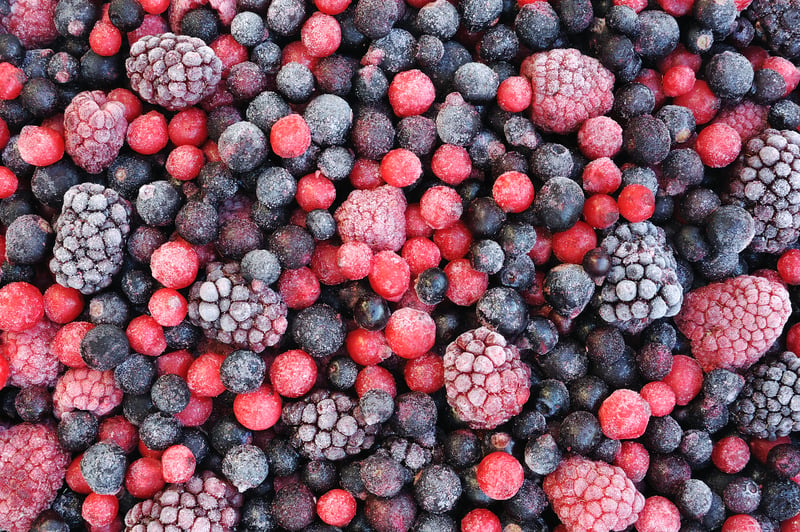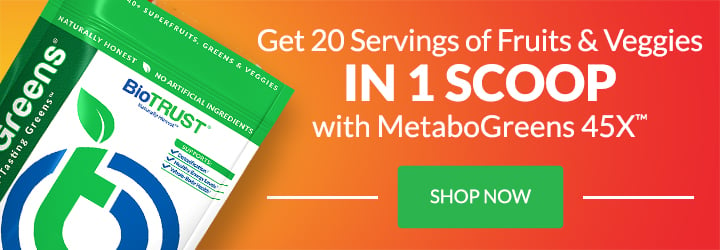Fresh vs. Frozen Fruits and Vegetables—Which Are Healthier?

One of the best recommendations when it comes to healthy eating is to “eat the rainbow.” This is an easy way to say your diet should be filled with a variety of colorful fruits and vegetables and is commonly advised because the color of your food can actually tell you a lot about its nutritional value. Subsequently, filling your plate with an assortment of colors can ensure you’re getting as many vitamins and minerals as possible from your food.
Not only does a colorful plate look inviting but maintaining a diet filled with fruits and vegetables has been linked to an abundance of health benefits, including lowered blood pressure, reduced risk of cardiovascular disease, prevention of some cancers, decreased risk of digestive problems, and help keeping your appetite in check.
One study looking into the impact of fruits and vegetables in the diet found that increased fruit and vegetable intake each day reduced the risk of premature death by 42% and ultimately decreased death from cancer by 25% and heart disease by 31%.1
Nevertheless, finding an array of fresh fruits and veggies to fill your diet can be difficult and time-consuming, especially depending on where you live. Luckily, fruits and vegetables are becoming more easily accessible and can be bought frozen as an easy alternative to fresh. But do frozen fruits and vegetables contain all the same vitamins, minerals, and antioxidants as fresh?
Generally, the rule of thumb is that fresh is best, but is that actually true? Let’s compare fresh vs frozen fruits and vegetables.
Fresh vs Frozen Fruits and Vegetables: What’s Best?
Fresh Fruits and Veggies
All fruits and vegetables must be grown, processed, and transported before reaching the shelves at the supermarket. Growing is largely influenced by soil and weather conditions. Once grown, the produce must be harvested and then processed.
To process fresh fruits and vegetables, they are run through procedures, which might include clearing debris, washing, and sorting them by size. Some fresh produce will then go through waxing, which can help prevent bruising, delay decay, and make grocery store produce look more appealing on the shelf.
Once processed, the produce must be transported, which involves the pass-through of several different supply chains before they make it to the grocery store. During transportation, fresh produce is then typically stored in a chilled, controlled atmosphere to prevent spoiling.
Fresh fruits and vegetables are either post-harvest ripened or vine-ripened. Post-harvest ripened means the fruit or vegetable will ripen during transport and is seen with much of the produce in most major supermarkets. Vine-ripened means the produce is picked and sold when ripe, as seen at local farmer’s markets. For some fruits and vegetables, the concentration of many vitamins and minerals is highest during the early stages of growth and allows the produce to continue to synthesize macronutrients and micronutrients during post-harvest. Yet the handling of the fruit or vegetable during post-harvest also makes a major impact on the nutrient profile. 2
Several studies suggest that post-harvest ripened produce is nutritionally equivalent to vine-ripened produce. Some researchers even concluded that some post-harvest fruits may be even more nutritious as they may accumulate more antioxidants. 3 Nevertheless, after reaching peak ripeness and optimal nutritional values, vitamins and minerals begin to diminish the longer the produce is stored.
Surprisingly, some of the fresh foods we are getting at the supermarket may be older than we think. Fruits and vegetables may spend anywhere from a few days to several weeks in transit before arriving at a distribution center. Additionally, the USDA states that some produce, such as apples and pears, can be stored for up to 12 months under controlled conditions before being sold.
Once they reach the supermarket, fruits and vegetables can then spend an additional one to three days on display before they are bought and stored in people’s homes and then eaten. With this in mind, it is important that we are consuming our fresh fruits and vegetables in a timely manner, rather than forgetting about them in the refrigerator, to make sure we are reaping all the nutritional benefits.
Frozen Fruit and Vegetables
Frozen produce, on the other hand, is fully vine ripened before processing. Then once it’s harvested, it’s typically washed, cut, and blanched before being frozen and packaged within hours. Most vegetables undergo blanching in hot water for a few minutes before freezing, in order to inactivate enzymes that may cause unfavorable changes in color, smell, flavor, and nutritional value.
Although blanching vegetables may break down some heat sensitive biomolecules like vitamin C and B vitamins, the majority of their nutrients are preserved, making them just as nutritiously composed as fresh. 4
Contrastingly, fruits tend not to undergo blanching, as this can greatly affect their texture. Instead, fruits are often treated with either ascorbic acid (a form of vitamin C) or added sugar to help prevent spoiling and discoloration.
As it turns out, some frozen fruits and veggies, like corn, broccoli, green beans, cauliflower, Brussels sprouts, spinach, winter squash, asparagus, berries, peaches, and cherries, can be equally as good as fresh, maybe even better. However, that is not true for all frozen produce. The main impact of blanching seems to be on taste as certain fruits and vegetables lose their unique just-picked flavor. As a result, frozen produce selection is often much more limited as only designated fruits and vegetables that can thaw out well and can retain their flavor are offered in the frozen aisle.
Nevertheless, evidence suggests that freezing can preserve nutrient value, and the nutritional content of fresh and frozen produce is similar, and any nutrient decline is typically small. 5 Some studies even go as far as to say some frozen fruits and vegetables may retain their nutrients better than fresh. 6
The biggest appeals to frozen fruits and vegetables are lower cost, convenience, and longer shelf life. Frozen fruits and vegetables have a shelf life of approximately eight months. This does not, however, make them immune to losing their nutrients over time. Nutritionists say that even frozen foods can begin to decrease in nutrient density after three months.
Fresh vs Frozen Fruits and Vegetables: Recap
Regardless where you stand on the fresh vs frozen fruits and vegetable debate, consuming a diet full of produce is the best way to get the maximum benefits from your food. Regardless of how you are getting your fruits and vegetables, they are important staples in a heathy diet that can add a pop of color and variety to any meal.
According to the USDA’s MyPlate model for healthy eating, half of your plate should be filled with colorful fruits and vegetables. Furthermore, the USDA recommends consuming between 5 and 13 servings of fruits and vegetables per day depending on your age, gender, physical activity levels, and overall health.




 7 Signs Your Body is Seriously Low on Collagen (not just wrinkles)
7 Signs Your Body is Seriously Low on Collagen (not just wrinkles) Health Expert: "Turmeric Doesn't Work (unless...)"
Health Expert: "Turmeric Doesn't Work (unless...)" 3 Warning Signs Your Probiotic Supplement is a Total Waste
3 Warning Signs Your Probiotic Supplement is a Total Waste

